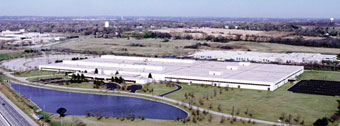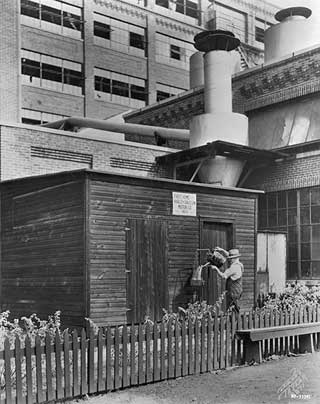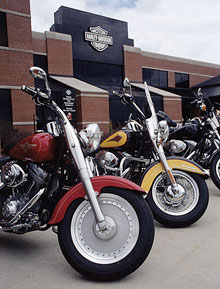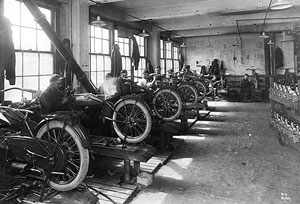NORTH AMERICAN REPORTS
Mandates and Manpower
Those jobs still are pretty high- wage in anybody's book, and state and local leaders are glad to have them. While there are plenty of service- sector jobs that pay decent wages,
 |
| Harley- Davidson's largest powertrain facilities in Menomonee Falls are a far cry from the original shed of William S. Harley and Arthur Davidson, seen here in 1903.
Photo: Harley- Davidson Archives; Copyright H- D |
 |
Working on the state's package of incentives was something the state was going to be doing anyway – in a more general sense – as Gov. Doyle's between- terms transition team readies a budget proposal for January, says Corey Nettles, Gov. Doyle's former Secretary of Commerce, now working as a partner in the Corporate Services and Government Relations groups for Milwaukee- based law firm Quarles & Brady LLP.
"I think Governor Doyle will continue to say the economy is the most important item on the agenda, because everything else he wants to accomplish costs money," says Nettles. "He'll spend some time looking at the hodge- podge of state incentives that are scattered throughout state government," which may be streamlined, in addition to tax and regulatory reform, he says. But the big step in taxation may have already occurred with the three- year phase- in, begun in 2005, of the state's single- sales factor taxation apportionment formula (as opposed to the former property/payroll/sales formula). That measure is expected to result in corporate income tax savings of more than $45 million for Wisconsin companies.
"It's huge," says Nettles, citing first- hand conversations with corporate CFOs pointing to corporate taxation as one of their line items under examination. Nettles says the measure went beyond the immediate fiscal and job- creation impact to send a message that Doyle's administration was going to be pro- business in a state where, culturally, "there's a sense that taxes are too high." The Harley- USW agreement sends out its own message against that backdrop.
"It shows that, increasingly, management and labor are prepared to sit down at the table here in Wisconsin and arrive at win- win solutions," says Nettles. "As opposed to a zero- sum game where 'we win, you lose,' they're asking, 'How can we work together?' That's not always an easy negotiation or set of discussions."
A Question of Supply
A Rand Corp. report several years ago documented how Harley- Davidson had cut its supplier base from 4,000 to 800 and worked with suppliers to reduce its materials costs by $40 million between 1996 and 2000, while also reducing product development time and defect levels on parts.
According to the September 2005 Wisconsin manufacturing study performed by The MPI Group, among Wisconsin's economic drivers, "industrial machinery is Wisconsin's single largest export industry and its second most productive in terms of dollars of exports produced per employee." But that's changing: Witness the fact that Harley- Davidson's
 |
| The Harley- Davidson product lineup, like its assembly lines, has seen a lot of design innovations, all authored in Milwaukee. Photo: Harley- Davidson Archives; Copyright H- D |
 |
If Wisconsin is going to retain its share of that strong global sector, it will have to retain and retrain its share of skilled workers. Welders are often cited as Exhibit "A." In these pages in November, Liebherr Mining Equipment Co. President Joachim Janka said his Hampton Roads- area firm in Virginia was ranging as far afield as Wisconsin in search of heavy welders. But even similar manufacturers in Wisconsin itself have been having a tough time.
"Down the street form Harley is Bucyrus Erie, which manufactures mining equipment," says Tim Sheehy. "There are now openings for 200 to 300 welders and machinists, paying an average salary of $60,000 to $90,000. Their average age is 58 years old. No one can view a crystal ball into the future, but for the next decade or so, they see prospects growing, assuming they can find, hire and train heavy- plate welders."
Bucyrus employed about 5,000 people at its peak, and has employed as few as 175. When work dried up in the 1970s and 1980s, it effectively "chilled a generation from pursuing that work," says Sheehy. But China, far from being the job taker it's traditionally made out to be, is a job maker in the industrial machinery business. Now it's up to employers, tech schools and high schools to fashion a nimble training model that can adjust to the market's ebbs and flows, says Sheehy, and a new coalition in the Milwaukee area is doing just that.
"The companies looking for these welders have now got themselves aligned around a 12- week accelerated course paid for in large part by the employers, and the open house drew 600 to 800 people," he reports.
In the meantime, Harley continues to build its reputation as what Nettles calls "one of those pre- eminent international corporate citizens." In addition to keeping its headquarters in Milwaukee's center city (rather than some greenfield "Taj Mahal," says Nettles), the company has worked to stabilize its immediate neighborhood, investing in everything from housing initiatives to urban park clean- up, the arts to its new Harley- Davidson museum, which looked at three redevelopment candidate sites before picking the Menomonee Valley area.
That $90- million project will trace the illustrious history of one of the globe's leading brands. And it will tell the story of how Milwaukee has adapted along with its favorite company to keep its profile as un- flat as the company's earnings. As Tim Sheehy puts it:
"No longer does a good alarm clock and a strong back guarantee you a job into the future."

